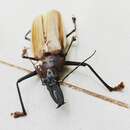en
names in breadcrumbs


Macrodontia is an American genus of long-horned beetles remarkable for their large size and for the large mandibles of the males in particular.
The genus Macrodontia Lepeletier, Audinet-Serville & Lacordaire, 1830 is in some documents credited to Latreille as the authority,[1] but this appears to be an error, possibly due to confusion arising from Latreille having been the authority for the subfamily Prioninae and the family Cerambycidae. It is a genus within the family Cerambycidae, subfamily Prioninae, tribe Macrodontiini.
The following species are recognised in the genus Macrodontia:
The species are large. Some are giants among insects, with occasional specimens more than 17 cm long. The habitus is fairly typical of the Cerambycidae, except for the enormous jaws of the males: elongated, more or less parallel-sided beetles with dorsiventrally flattened bodies, generally all brown or orange with longitudinal dark striping. The males are larger than the females and generally have enormous jaws, from which the generic name derives: Macrodontia is from the Greek μάκρος (makros) meaning "long or large" and ὀδόντος, (odontos) meaning "of a tooth".
In contrast, in proportion to the beetles' size, the antennae are shorter than those of typical Cerambycidae.
The genus was originally described from South America, but the 11 currently recognised species variously range from regions between Guatemala at the north of Central America, or even Southern Mexico, to Argentina in South America.
Macrodontia is an American genus of long-horned beetles remarkable for their large size and for the large mandibles of the males in particular.
Macrodontia es un género de escarabajos longicornios de la subfamilia de los prioninos. Fue descrito como originario de Sudamérica, pero las 11 especies conocidas están en un rango que comprende entre Guatemala (o talvez sur de México) a Argentina.
Este género incluye las siguientes especies:
Macrodontia es un género de escarabajos longicornios de la subfamilia de los prioninos. Fue descrito como originario de Sudamérica, pero las 11 especies conocidas están en un rango que comprende entre Guatemala (o talvez sur de México) a Argentina.
Macrodontia est un genre d'insectes coléoptères de la famille des Cerambycidae, notamment présent en Guyane[1],[2] et au Brésil[3]
Le genre Macrodontia a été décrit par l’entomologiste français Théodore Lacordaire en 1830.
Macrodontia est un genre d'insectes coléoptères de la famille des Cerambycidae, notamment présent en Guyane, et au Brésil
Macrodontia adalah genus kumbang tanduk panjang yang tergolong famili Cerambycidae. Genus ini juga merupakan bagian dari ordo Coleoptera, kelas Insecta, filum Arthropoda, dan kingdom Animalia.
Larva kumbang dalam genus ini biasanya mengebor ke dalam kayu dan dapat menyebabkan kerusakan pada batang kayu hidup atau kayu yang telah ditebang.
Macrodontia adalah genus kumbang tanduk panjang yang tergolong famili Cerambycidae. Genus ini juga merupakan bagian dari ordo Coleoptera, kelas Insecta, filum Arthropoda, dan kingdom Animalia.
Larva kumbang dalam genus ini biasanya mengebor ke dalam kayu dan dapat menyebabkan kerusakan pada batang kayu hidup atau kayu yang telah ditebang.
Macrodontia is een kevergeslacht uit de familie van de boktorren (Cerambycidae). De wetenschappelijke naam van het geslacht werd voor het eerst geldig gepubliceerd in 1830 door Lacordaire.[1]
Macrodontia omvat de volgende soorten:
Macrodontia is een kevergeslacht uit de familie van de boktorren (Cerambycidae). De wetenschappelijke naam van het geslacht werd voor het eerst geldig gepubliceerd in 1830 door Lacordaire.
Macrodontia er en slekt av biller som hører til familien trebukker (Cerambycidae). Slekten inneholder en av verdens største biller, Macrodontia cervicornis.
Store til meget store (50-170 millimeter om man regner med kjevene) trebukker. Artene utmerker seg ved svært kraftige, forlengede kjever (mandibler) som utgjør en ikke ubetydelig del av kroppslengden, særlig hos hannene. Kroppsformen er avlang og nokså flat, pronotum har kraftige pigger på ytterkanten. Dekkvingene er gjerne mørke med lyst nettmønster, beina middels lange og nokså spinkle. Antennene er kortere enn kroppen, mot spissen ganske tynne.
Larvene lever i død ved, utviklingstiden er flere år. Disse artene holder til i tropisk regnskog.
Artene er utbredt i Sør- og Mellom-Amerika, fra Guatemala i nord til Argentina i sør.
Macrodontia er en slekt av biller som hører til familien trebukker (Cerambycidae). Slekten inneholder en av verdens største biller, Macrodontia cervicornis.
Macrodontia là một chi bọ cánh cứng Bắc Mỹ được Lepeletier & Audinet-Serville miêu tả năm 1830 trong phân họ Prioninae, tông Macrodontiini.
Chi này ban đầu phân bố ở Nam Mỹ, nhưng có 11 loài phân bố từ Guatemala đến Argentina.
Macrodontia gồm các loài sau:
Phương tiện liên quan tới Macrodontia tại Wikimedia Commons
Macrodontia là một chi bọ cánh cứng Bắc Mỹ được Lepeletier & Audinet-Serville miêu tả năm 1830 trong phân họ Prioninae, tông Macrodontiini.
Macrodontia Lepeletier & Audinet-Serville, 1830
Macrodontia — род крупных жуков из семейства Усачи, распространённых в Южной Америке от Гватемалы до Аргентины.
Известно 11 видов.
Macrodontia — род крупных жуков из семейства Усачи, распространённых в Южной Америке от Гватемалы до Аргентины.
Macrodontia batesi
長牙大天牛Macrodontia cervicornis
Macrodontia crenata
Macrodontia dejeani
Macrodontia flavipennis
Macrodontia jolyi
Macrodontia marechali
Macrodontia mathani
Macrodontia zischkai
Macrodontia Lepeletier & Audinet-Serville, 1830是天牛科锯天牛亚科下的一属,仅分布于拉丁美洲。
该属天牛通常尺寸较大,身体扁平且不透明。在花纹上,有的通体棕色,有的则为橙底竖纹黑条。
该属雄性天牛通常拥有巨大的颌部,因此,其拉丁语学名为“Macrodontia”,意为“巨大的牙齿”。
另一方面,与其他天牛相比,其触角的长度就相对较短。
在中国,该属天牛通常被称作“长牙大天牛”。
该属原产自南美洲,目前已知有11个种,从危地马拉直到阿根廷都有该属天牛分布。 但该属内的几种天牛,无论在下文所列或是尚未被描述,向北也有可能分布至墨西哥南部。
Macrodontia属 包括以下几种:
Ed.